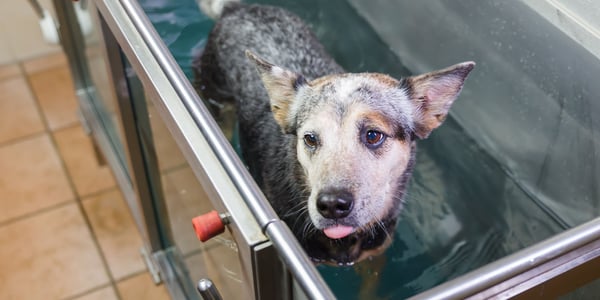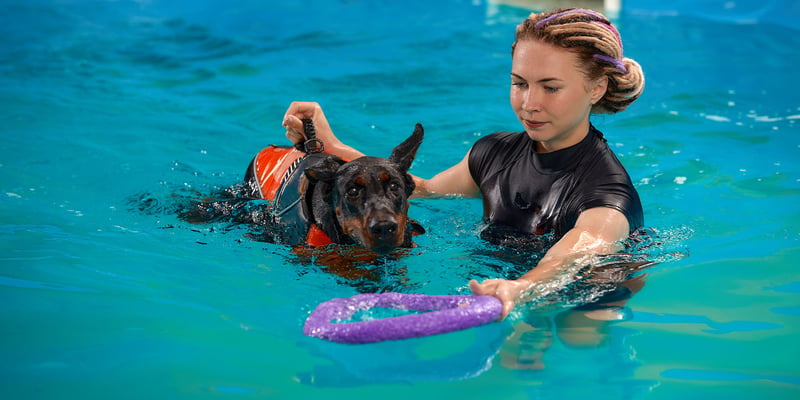Hydrotherapy for Dogs - What Is It and Does It Work?
Index:



Introduction
Hydrotherapy is a growing trend in canine physical therapy and refers to exercise in water. Hydrotherapy, recognised since ancient times, uses the buoyancy of warm water to exercise muscles with reduced joint and limb strain and helps dogs to rehabilitate after injury or surgery.
In this article, we’ll discuss the definition of hydrotherapy, explore its historical background, how its use for dogs emerged from the horse-racing industry, how it’s used to treat injury and other health conditions, and how it can be useful in preventing injury and ailments.
What is hydrotherapy?



Hydrotherapy is a therapeutic approach that involves the use of water, in various forms, for the treatment of medical conditions and the promotion of overall well-being. It includes a wide range of techniques such as immersion in warm water, water exercises, and the application of water in different forms like steam and ice.
The use of hydrotherapy dates back to ancient civilisations, including the Greeks, Egyptians, and Romans. These cultures recognised the healing properties of water and utilised it in various forms such as communal bathhouses, for example.
Hydrotherapy experienced a resurgence in popularity during the 18th century, particularly in Europe. The practice was advocated by figures like Vincent Priessnitz, a Czech farmer who is now considered one of the pioneers of modern hydrotherapy.
Hydrotherapy for animals also has a long history. The ancient Egyptians utilised water therapy for their horses and other animals, recognising its benefits in promoting healing, recovery and strength.
Hydrotherapy also saw a rise in popularity during the 20th century. Initially, it was primarily used for racehorses and greyhounds to aid in recovery from injuries and enhance performance.
However, hydrotherapy for animals evolved over time and is now widely utilised in veterinary practices around the world. It's used for a variety of purposes, including post-surgical rehabilitation, arthritis management, and general animal fitness.
Hydrotherapy for dogs



The use of hydrotherapy for dogs originated in the horse racing industry due to the need for effective methods to enhance the performance and recovery of racehorses. In the mid-20th century, horse trainers and veterinarians sought innovative ways to maintain the fitness and well-being of their equine athletes.
They found that water-based exercises and activities offered a unique combination of low-impact, full-body conditioning while minimising stress on the horse's joints and limbs.
This led to the development of specialised facilities and techniques for hydrotherapy in horse racing that have since been passed on to canine care providers.
As the benefits of hydrotherapy became more evident in the equine world, the principles and techniques were adapted for other animals, including dogs.
The success in treating and rehabilitating racehorses paved the way for the expansion of hydrotherapy into veterinary practices, where it is now widely used to aid in the recovery, rehabilitation, and fitness of a variety of animals.
There are two primary forms of canine hydrotherapy widely employed today:
Swimming: This form of hydrotherapy involves allowing the dog to swim in a controlled environment, such as a specially designed and heated hydrotherapy pool. Swimming provides a low-impact, full-body workout (as mentioned above) and promotes muscle strength, flexibility, and cardiovascular fitness. It's particularly beneficial for dogs recovering from surgery, managing arthritis, or those with mobility issues.
Underwater treadmill: In this method, a treadmill is enclosed within a small tank or chamber filled with water. The water level can be adjusted to vary the resistance. The dog walks or exercises on the treadmill, benefiting from the buoyancy of water, which reduces stress on joints while providing a controlled workout.
This is especially effective for gait training, building muscle strength, weight loss, and improving range of motion.
Structured hydrotherapy programmes
Structured hydrotherapy programmes are programmes tailored to address specific rehabilitation needs in dogs. These programmes are overseen by trained professionals, often including veterinary rehabilitation therapists or hydrotherapists.
They are mainly designed to aid dogs recovering from soft tissue injuries, surgeries, or managing chronic conditions. Through a combination of swimming, treadmill exercises, and targeted techniques, these programmes aim to enhance mobility, reduce pain, and expedite the healing process.
They are typically customised to each dog's individual needs and are continuously monitored by professionals to ensure safe and effective progress. Such programmes have proven to be highly effective in restoring function and improving the quality of life for dogs facing a range of physical challenges.
Treating dogs with hydrotherapy
Hydrotherapy can be effectively used to treat a range of canine conditions and injuries. Let’s take a look in further detail.
Arthritis: Hydrotherapy provides a buoyant, low-impact environment that reduces stress on arthritic joints, allowing dogs to exercise and strengthen muscles without exacerbating pain. The warm water also helps to soothe discomfort and promote relaxation. These benefits collectively improve joint mobility and alleviate stiffness, overall enhancing the quality of life for dogs with arthritis.
Neurological problems: For dogs with neurological issues, such as spinal cord injuries or degenerative conditions, hydrotherapy offers a controlled environment where they can move without the constraints of gravity. This can aid in mental stimulation , retraining neural pathways and improving coordination. The resistance of the water provides a gentle yet effective way to build strength and support muscle function, contributing to better mobility and stability.
ACL injuries: Canine ACL (anterior cruciate ligament) injuries are common and can be very painful; fortunately, hydrotherapy plays a crucial role in rehabilitation. Hydrotherapy treatment though underwater treadmills, allow controlled movement, facilitating gait retraining and muscle strengthening without placing excessive stress on the healing ligament. The buoyancy of water reduces weight-bearing, helping to protect the injured knee while promoting a smoother recovery.
Other orthopaedic conditions: Dogs with various orthopaedic issues, such as hip dysplasia, osteoarthritis, and degenerative joint diseases can also benefit from hydrotherapy. The water's buoyancy supports their weight, alleviating pressure on affected joints. This enables dogs to engage in therapeutic exercises that enhance range of motion, muscle tone, and joint flexibility. The warmth of the water promotes circulation, aiding in pain relief and reducing inflammation.
Post-surgical recovery



After orthopaedic surgeries, including procedures for ACL repair or joint replacements, hydrotherapy is an invaluable component of rehabilitation. The controlled aquatic environment allows for gentle, progressive movement that encourages healing without risking complications.
It helps prevent muscle atrophy, supports proper weight distribution, and accelerates the restoration of normal function, ensuring a smoother recovery process for the dog.
Hydrotherapy also proves highly beneficial in addressing weight management and metabolic conditions in dogs.
The buoyancy of water significantly reduces the impact on joints, making it an ideal form of exercise for overweight or obese dogs.
The resistance provided by the water engages muscles effectively, aiding in calorie and weight loss. Moreover, the controlled environment allows for gradual, low-impact workouts that can be tailored to the individual needs and limitations of each dog.
For dogs with metabolic conditions such as diabetes or thyroid disorders, hydrotherapy offers a controlled exercise environment that helps regulate blood sugar levels and metabolism.
The water's resistance encourages muscle engagement, which can improve insulin sensitivity. Warm water also stimulates circulation, aiding in metabolic processes and overall well-being.
Hydrotherapy for physical conditioning and preventing injuries
Sporting dogs and highly active breeds benefit greatly from including hydrotherapy in their physical conditioning.
Hydrotherapy offers a low-impact, joint-friendly exercise option, reducing the risk of strain and injury. This is crucial for breeds prone to musculoskeletal issues. It also enhances flexibility, muscle tone, and overall strength.
Hydrotherapy improves stamina and endurance. The water's resistance challenges their cardiovascular system, leading to better cardiovascular health and increased aerobic capacity.
Tailored training regimens in this controlled environment target specific muscle groups, creating a more balanced and efficient physical condition.
Hydrotherapy also helps to aid post-exercise recovery. The water's properties, like buoyancy and hydrostatic pressure, alleviate soreness and reduce inflammation in muscles and joints.
This speeds up the healing process, allowing dogs to recover faster and maintain peak performance levels.
Integrating hydrotherapy ensures these dogs stay in optimal health, excelling in their chosen sports while minimising long-term wear and tear on their bodies.
Dog hydrotherapy at home
At-home hydrotherapy for dogs can be achieved through various options, each catering to different breeds and sizes.
For larger breeds, swimming pools provide an excellent space for hydrotherapy sessions. They offer plenty of room for dogs to move around, making it easier to engage in controlled exercises that promote strength and flexibility.
For smaller breeds, kiddie pools and paddling pools are a suitable alternative. These smaller, shallower pools allow for safe and controlled movement, catering to the specific needs and limitations of smaller dogs.
Regardless of the option you choose, we can’t stress the importance of supervision during at-home hydrotherapy sessions enough.
A watchful eye ensures your dog's safety and helps prevent any potential accidents. The use of appropriate equipment, such as flotation jackets, is essential.
These aids provide buoyancy and support, especially for dogs who may be less comfortable or confident in the water.
Before initiating any at-home hydrotherapy programme, consulting with your vet is crucial. They can offer tailored advice based on your dog's health, condition, and specific requirements. This professional guidance ensures that the hydrotherapy regimen is both safe and effective, addressing any specific concerns or considerations for your dog's well-being. By incorporating these measures, you can provide a safe and effective hydrotherapy experience for your dog in the comfort of your own home.
Providing hydrotherapy for your dog



In recent years, the UK has witnessed a notable growth in hydrotherapy clinics and veterinary facilities offering hydrotherapy for dogs. This surge can be attributed to the increasing recognition of the benefits of aquatic therapy in canine rehabilitation and fitness. Many clinics now offer specialised facilities equipped with state-of-the-art underwater treadmills and swimming pools designed to cater to the specific needs of dogs.
Before beginning hydrotherapy sessions, we recommend consulting with veterinarians and certified rehabilitation specialists.
These professionals possess the expertise to assess a dog's individual needs, recommend appropriate exercises, and monitor progress throughout the therapy process. Their guidance ensures that the hydrotherapy regimen is tailored to address specific conditions or injuries, optimising the benefits derived from each session.
In terms of cost, hydrotherapy sessions can vary depending on factors such as location, facility amenities, and the level of expertise provided. On average, a single session may range from £30 to £60, with packages and memberships often available for discounted rates.
It's important to inquire about pricing structures and any potential additional fees before providing your dog with hydrotherapy so you have a clear understanding of the financial commitment involved.
The investment in hydrotherapy can be a valuable component of a dog's overall health and rehabilitation plan.
Does Waggel Pet Insurance cover hydrotherapy?
At Waggel, our Lifetime policies cover up to £1,000 every year for complementary treatments including hydrotherapy. Every time you renew your policy, we’ll reset your cover limits back to £1,000 which means you won’t have to worry about long-term conditions such as arthritis and can continue to claim in the future.
However, in order for a complementary treatment claim such as hydrotherapy to be approved it must be administered by a suitably qualified practitioner following a vet’s recommendation. This means we can’t cover the cost of hydrotherapy if you decide yourself that your dog needs it.
If you’re new to the world of pet ownership and insurance, we recommend reading our article on different types of pet insurance so you can find a policy that suits you and your pet best.
At Waggel, we only offer monthly payments for our Lifetime policies making it more affordable. We also only use one level of Annual Limit to make pet insurance more accessible and simple.
It’s important to know that not all pet insurance providers in the UK will provide cover for complementary treatments for things such as hydrotherapy so we encourage you to do your research! For information on average costs, take a look at our in-depth blog post.
Taking out a pet insurance policy is also important for puppies too. Though they’re incredibly tiny and cute, puppies aren’t immune to developing conditions or having injuries at a young age including those that would need hydrotherapy to aid recovery. Pet insurance is incredibly necessary for dogs of all ages and breeds, not only helping you save money on expensive vet bills but insuring your dog has access to a wide range of treatments.
Conclusion
In conclusion, hydrotherapy offers a wide range of benefits and proven effectiveness for dogs of all ages. It provides a low-impact, joint-friendly exercise option, reducing the risk of strain and injury, which is particularly crucial for active breeds.
Hydrotherapy also improves stamina, endurance, and muscle strength, making it an ideal component of athletic conditioning programs.
It aids in post-exercise recovery, alleviating soreness and reducing inflammation in muscles and joints.
The controlled water environment also allows for tailored training regimens, targeting specific muscle groups for a more balanced and efficient physical condition.
If you’re a dog owner, we recommend consulting with your vet to explore hydrotherapy as a viable option for your pup’s health and wellness. Vets can provide expert guidance on hydrotherapy and how to incorporate it into a dog's care plan, ensuring it's tailored to their specific needs and conditions.
This professional advice helps maximise the benefits of hydrotherapy. With its numerous advantages, hydrotherapy stands as a valuable tool in maintaining a dog's optimal health and performance.
Waggel Pet Insurance
Need more help? You're in luck if you're a Waggel Pet Insurance member. Along with our excellent coverage, we offer access to a 24/7 online vet to answer all your sticky questions, especially if you need grooming assistance.
Not a member? Why not get a quote now and cover your furry friend for a range of illnesses, all while enjoying our amazing perks and rewards.
Want more like this?
Get updates from us with helpful info, advice, answers to frequently asked questions and much more.
Index:
- Introduction
- What is hydrotherapy?
- Hydrotherapy for dogs
- Structured hydrotherapy programmes
- Treating dogs with hydrotherapy
- Post-surgical recovery
- Hydrotherapy for physical conditioning and preventing injuries
- Dog hydrotherapy at home
- Providing hydrotherapy for your dog
- Does Waggel Pet Insurance cover hydrotherapy?
- Conclusion
Related posts:
Get your quote
Along with our excellent coverage, we offer access to a 24/7 online vet to answer all your sticky questions.





